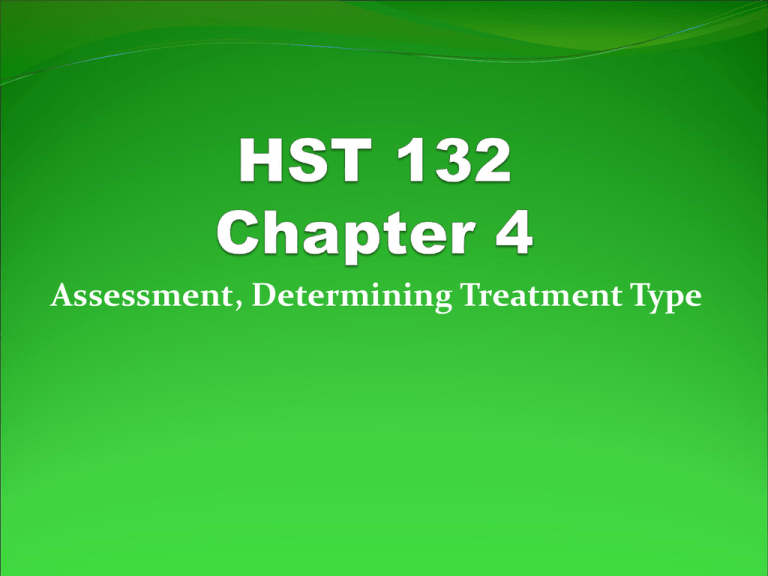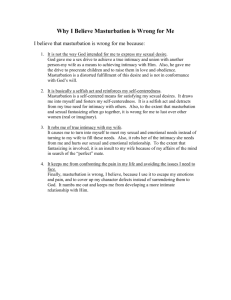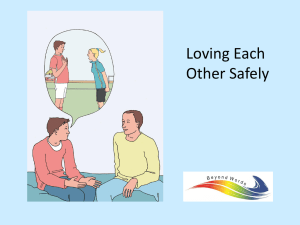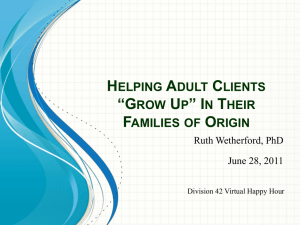
Assessment, Determining Treatment Type
Level of social functioning
There are many different capability levels within the community and
within the population diagnosed with developmental disabilities
Some benefit greatly from more verbal strategies and cognitive
behavioral strategies, some do not.
The question to ask is:
“Is this person’s freedom of movement and access to the community
limited solely because of the sexual behavior?”
The answer for the group participating and benefitting from a therapy
group, the answer was a resounding, YES.
For others, that answer was…even if the sexual behavior was changed,
this person would still need support and, therefore, supervision in the
community and/or while living in his/her home
So…if the person was limited only because of his/her sexual behavior,
the authors chose to treat actively…if there were other limitations, the
authors chose to do something else entirely
Some Key Concepts:
1.
2.
3.
4.
5.
6.
7.
Even if you have disabilities that severely impact on your freedom of movement, you still
need the freedom to get all your needs met.
Sexual offenses done against people with disabilities are serious crimes, even if the offender
has similar disabilities.
Agencies that serve people with disabilities cannot choose whom amongst that population
they will serve. People with significant disabilities have a right to treatment tailored to
their needs and that will, in the end, enhance the quality of their lives.
Just because the work is hard, doesn’t mean you don’t do it.
It’s ok to provide different service to different people, it’s called “individualized treatment”.
Denying that difference makes a difference makes it impossible to provide “individualized
treatment”.
It is unfair to say that it’s unfair to provide one kind of treatment for those with greater
abilities and another kind for those with greater disabilities. Political correctness can’t be
the guiding force in determining effective treatment. The only question that an ethical
practitioner has to answer to justify a treatment approach is, “Is the person’s quality of life
greater after we’ve worked together than it was before our work began?” If the answer is
any form of “Yes,” then ethical programming has occurred.
So…how do you
proceed with
treatment…what
are the goals?
Reduce the
likelihood of future
sexual offense
2. Help the person
devise ways to meet
affection and
intimacy needs in
appropriate ways
3. Increase their
overall access to
preferred activities
1.
Primary reasons for referral for
treatment for those diagnosed
with profound disabilities:
They are sexually touching another person with a
disability
2. They are masturbating at inappropriate times and places
3. They engage in behaviors that make them vulnerable to
sexual assault
For each, we need to make sure that the appropriate supports
are in place.
1.
Creating appropriate staff support:
We need to train staff
A crime against someone with a disability is still a crime
even if the offender is also disabled
The greater a person’s disability, the more likely it is that they
will be abused
The group that is second most likely to offend against a person
with a disability is another person with a disability (the most
likely to offend is a care provider)
People have a right to have a safe working and living
environment
Offenders have a right to appropriate consequences and
treatment that makes sense
Law and Responsibility:
1.
2.
3.
4.
If someone engages in the same behavior over and over again, they get skilled at it and
they know what they are doing. The may not understand that it’s wrong and that they
shouldn’t do it, that’s not the same as knowing what they are doing
A crime is committed when a law is broken. A woman who is raped is still raped even if
the person who did it is found not competent to stand trial. The crime is the act—it is
independent of the person who did it. A loaf of bread is still stolen even if the person
who took it has starving children to feed.
Not acting to protect people with disabilities from ALL abusers is a mammoth lack of
responsibility. Staff have got to care about creating a safe environment for a person with
a disability to live in. If the staff don’t take the behavior seriously, then abuse will
continue. In fact in one institution, they set a goal for the reduction of the assaultive
behavior. They wanted it to get down to one rape per month!
Victims of sexual assault, no matter their level of ability, are always traumatized by the
assault. So many times we have heard it said, “Yeah, she was raped last Monday but it
doesn’t seem to have affected her” or “He has a horrible abuse history, but you would
never know it from his behavior.” The speakers are assuming, though they are not saying
it directly, that the person with the disability is “too dumb to notice” that they’ve been
victimized.
Squeaky wheel:
There are example after example of situations where a person
with a disability is told that they are “fine”, that nothing is wrong,
to ignore “teasing” or bullying and it will go away. The problem
is that without confirming that there is no pain or bullying, the
staff member may be “sentencing” this person to this
situation…the person learns that they are not worthy of
protection and that the staff don’t care about their pain
Hurt happens, trauma follows
Appropriate staff response comes with staff care enough to do
the job of risk reduction, risk management, and ongoing
supervision
Staff allegiance needs to start with the victim and then to the
victimizer. To support BOTH, the VICTIM must come first.
“But he’s such a sweet guy….” Sweet guys rape, good staff know
that.
Risk reduction:
By placing someone with a history of sexually
offending, you have increased the risk of sexual assault
for everyone in their environment.
It is imperative that work be done to ensure that those
others in the environment are protected (this is
independent of the level of ability of the offender).
More than that, the agency needs documentation to
show what steps have been taken to mitigate risk.
What are some strategies for this?
Risk Reduction…Supervision
Staff supervision needs to be 24/7, the sexual offender must be
supervised at all times. All steps MUST be taken to assure that they do
not gain access to a potential victim
Staff need to be aware of:
Potential victims
Where assaults might happen in an environment
When staffing levels are low or lacking
…AND THEN FIX THE ISSUES PROACTIVELY
This means that, working with the therapist, they need to design the
environment so that it is unwelcoming to offending behavior
This means that the sexual offender may need line of sight or side by
side supervision at all times
Staff have the RIGHT to have “supervision” spelled out clearly
Supervision also means providing extra caution and concern for those
who already have been victimized by this person or by those who might
be. Knowing where people who could be targets are in relation to the
client with concerning behavior should become standard practice.
Risk Reduction: Environmental Changes
The person may need their own bathroom and private
areas
The person may NEED an alarmed door and window
They may need a baby monitor in their room
They may need to be seated away from potential
victims
They may need their own, single chair in a living room
They may need a staff member assigned at all times to
be in the room with them and line of sight
Overnight awake staff is MANDATORY!
Risk Reduction: abuse prevention
All people, regardless of disability can learn to say no
to unwanted touch
Persons with developmental disabilities and staff
members need to learn appropriate boundaries and
the ethics of touch to learn when it is appropriate to
say no and what unwanted touch is
Prevention isn’t enough!
All people have needs for affection and intimacy,
simply preventing unwanted touch or sexual offending
does not meet the needs for affection and
intimacy…so, what do we know about not meeting the
needs a former behavior served?
But…how? Individuals with significant disabilities
would never be able to pass any kind of assessment
regarding informed consent. True, but to end there is
to take the easy way out of the dilemma
Intimacy vs. Sexual Expression
The drive and need for intimacy is greater than the drive and
need for sex
Research shows that people can go for years without sex without
suffering any mental health concerns, but that people can only
go for days without intimacy before they begin to experience
depression and isolation along with a feeling of
disconnectedness.
The word intimacy here is in reference to touch, a sense of
closeness, feeling embraced and other forms of social
interactions that occur with friends and family and are decidedly
not sexual.
Our goal is for persons with significant disabilities to experience
intimacy…here is the problem, we do not believe that it is
appropriate for staff to meet intimacy needs.
Some ideas to try:
Touch needs:
Prolonged shampoos
Electric blanket wrap
Dogs, cats, and rabbits
Massage (professional, NEVER STAFF)
Sensual needs:
Aroma therapy
Taste…spices, different foods
Sounds…music, birds, etc.
Why not just teach masturbation?
We never teach masturbation…either the person has
the skill or they do not.
If they are masturbating in the wrong place or at the
wrong time, we teach the appropriate place and time
The drive and need for intimacy is greater than the
drive and need for sex…masturbation isn’t enough,
intimacy needs are not met through masturbation
Human beings are complex, so are our needs
And a reminder that sexual
“oddness” is not just seen in
those with developmental
disabilities, nor in only those
with mental illness, but
everywhere…for your
consideration…please discuss.








